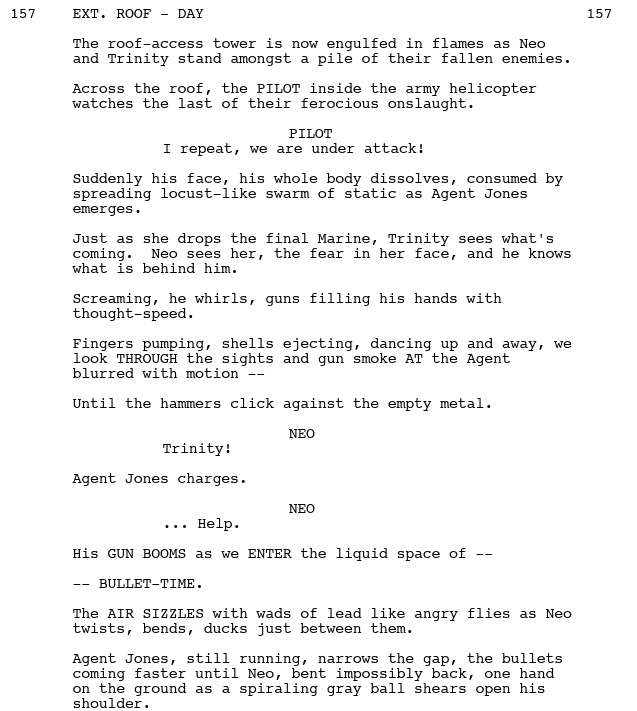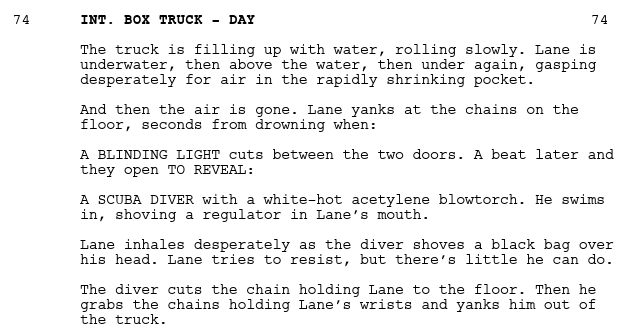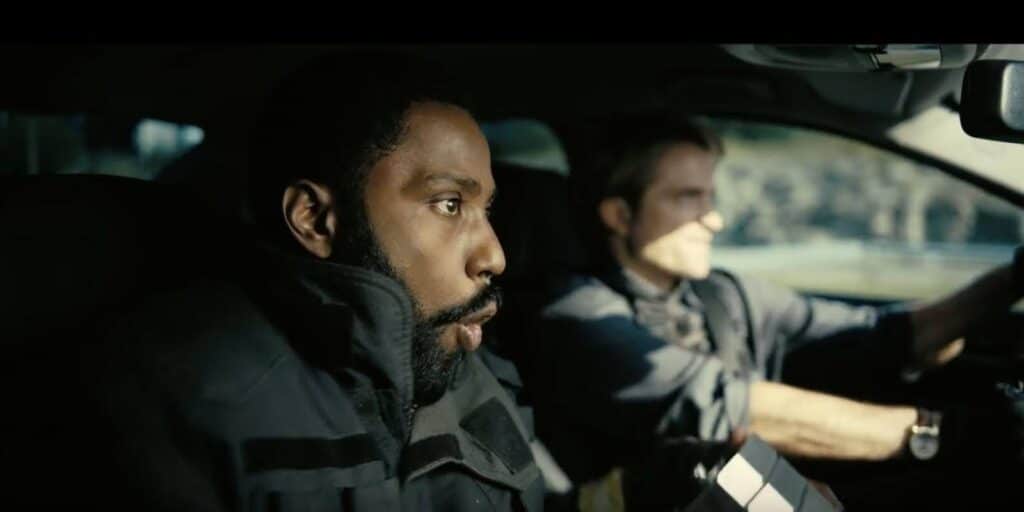
Welcome back to our Mastering the Art of Screenwriting series where we dive into all there is to know about screenwriting and the movie world.
If you’re an adrenaline junkie like me, then action is probably one of your favorite movie genres! I’m thinking car chases through neon-lit city streets and climatic battles atop skyscrapers.
Whatever the plot, you can guarantee it’ll be a high-stakes thrill ride that’ll keep you glued to the screen. But watching and writing an action movie are two vastly different things.
Crafting an action script isn’t just about stuffing it with spectacle. It’s about writing a coherent and engaging story that moves at a breakneck pace while staying grounded in character and theme.
So, for all you budding action screenwriters out there, in today’s blog we’ll break down the unique challenges of writing action scripts, explain the must-have elements, explore some action screenplay examples, and of course offer our famous top tips for getting your script noticed.
In This Article
- Taking on the Challenge of an Action Script
- Understanding the Core Elements: Stakes, Spectacle, and Structure
- How to Write an Action Scene
- Character Motivation in High-Octane Stories
- Formatting Action Sequences with Celtx
- Tips for Selling Your Action Script
- Conclusion

Taking on the Challenge of an Action Script
As we’ve just mentioned, action movies can seem straightforward with their huge stunts, big stakes and equally big moments. However, this simplicity is deceptive (sorry!)
If you want to write an effective script, it requires a careful balance between visual excitement and a clear narrative. No punch, explosion or high-speed chase can be there for the sake of it. Instead, they must be justified by story logic or character motivation.
Let’s break down the unique challenges of an action script.
1. They are Highly Visual
Unlike dialogue-heavy drama or comedy, action scripts need to communicate action clearly and dynamically on the page. That means concise, evocative writing that paints a picture without becoming a novel.
2. Pacing is Key
Action movies thrive on momentum, so the script must maintain tension and build towards larger set pieces without losing emotional depth or character development.
3. Money, Money, Money
Action moves are also one of the most expensive genres to produce. Naturally, this means that studios will scrutinize them more closely. Every scene will be meticulously checked to justify its cost in terms of storytelling value.
Despite all these challenges, none of them should be a reason to not write an action script. They’re simply things to bear in mind as you start planning and then move onto writing your script.

Explosions are optional. A strong story isn’t.
Use Celtx to outline, script, and structure your next high-octane screenplay.
Click here to sign up [it’s free!]
Understanding the Core Elements: Stakes, Spectacle, and Structure
Talking of writing an action script, there are three essential elements you need to consider: stakes, spectacle and structure (who doesn’t love a bit of assonance!)
Stakes
High stakes are what action scripts are all about! Without clear, immediate consequences, the action becomes flat and pretty much meaningless. Whether it’s saving a kidnapped child or stopping a nuclear warhead, the protagonist’s mission should feel urgent and personal.
Here are some questions you should ask yourself at the very start of your planning process:
- What does the protagonist stand to lose?
- How do the stakes escalate?
- Do the stakes affect more than just the protagonist?
If you can answer all these convincingly, you have a solid foundation from which to build the rest of the story.
There are some fantastic lessons to be learned from movies like Die Hard. Throughout the film, protagonist John McClane isn’t just battling terrorists but fighting to save his estranged wife. The emotional stakes elevate every shootout, making things personal for McClane. This is what the audience relates to, making them root for McClane to succeed.

Spectacle
It’s the spectacle that draws us into action movies, but it shouldn’t just be there. Every high-octane set piece must serve the story first and foremost.
Yes, a helicopter crash is exciting, but only if it matters. The best action films integrate spectacle with character growth and emotional resonance.
Take John Wick (2014) and the nightclub fight scene. This isn’t just stylized violence but reinforces Wick’s mythic status and shows his relentless drive and tactical brilliance as a fighter. Essentially, the spectacle builds his character.
To replicate spectacle like this, you should design each set piece to advance the plot, reveal character, and surprise the audience.
Structure
You’ll find most action scripts will follow the classic three-act structure. The key is adding flavor by escalating action with meaningful story beats, just like we talked about before.
Taken uses the three-act structure, each filled with tense and jaw-dropping moments. Every one is emotionally charged with actions driven by character motivation and need. Here’s an overview of the Taken structure:
Act One: Bryan Mills reconnects with his daughter before she’s kidnapped.
Act Two: He travels to Paris, confronting and dismantling a human trafficking ring.
Act Three: The climactic confrontation with the final captor allows him to rescue his daughter. This moment completes his emotional arc.

Related Reading: Three Act Structure in Screenwriting [A Complete Guide]
How to Write an Action Scene
Writing high-stakes action like this isn’t easy and takes careful crafting.
Unfortunately, it’s not enough to imagine an incredible set piece; you need to communicate it in a way that engages readers (often producers or agents) who are deciding whether or not to invest in your script.
But never fear, as we have some top tips up our sleeve to help you write killer scenes.
Firstly…
1. Keep it Punchy!
Use short sentences and paragraphs. Action scenes should read fast, mimicking the pace of the scene itself.
The Wachowski’s script for The Matrix demonstrates pacing through writing perfectly. Each section of action is distinct, with capitalized words and punctuation helping to visualize the scene for the reader without distracting.

Let’s see how this scene translated onto the screen:
2. Keep it Clear!
Avoid overly technical descriptions. Readers don’t need a frame-by-frame account of the scene (that’s what a storyboard is for!). Instead, they need the emotional and physical flow of the scene.
3. Don’t be afraid of white space
Allow your action to breathe on the page and don’t cram in long blocks of text. Line breaks and spaces create a clear rhythm for your reader to follow. Plus, it’ll make the script a lot easier to translate for actors and directors when it comes to shooting.
In Christopher McQuarrie’s script or Mission: Impossible Fallout, he uses white space to create a sense of pace. Here, in the scene where the villain Lane is captured, we have a clear idea of how the scene is to play out rhythmically and the elements we need to focus on.

Here’s how the scene played out:
4. Show, don’t direct
While ‘show don’t tell’ is a very common piece of screenwriting advice, ‘show, don’t direct’ is just as important.
Avoid using camera directions unless absolutely necessary and trust the director will bring the action to life. Our job as screenwriters is to make it readable and exciting.
Even the fastest car chase starts with a solid outline.
Build your script from the ground up with Celtx’s all-in-one script writing tools.
Click here to start writing
Character Motivation in High-Octane Stories
In any movie, characters drive the plot, and it’s no different for action movies. Without motivation, your protagonist is just a punching machine.
What separates John Wick from a generic revenge story? Well, it’s emotional clarity. The audience knows exactly why he fights and what he needs. That’s what makes his story compelling to us.
So, how can you replicate this for yourself? Here come some more top tips!
1. Define their internal and external goals
Everyone has both internal and external goals. For action heroes these could be:
External
- Stop the villain.
- Rescue the hostage.
- Survive the warzone.
Internal
- Redemption.
- Justice.
- Self-discovery.
- Closure.
To make things extra interesting, these goals should conflict or intersect. For example, perhaps achieving the external goal comes at the cost of the internal goal or vice versa. That’s where the real drama lies!
2. Create personal stakes
Their mission may be to save the world, but why does it matter to them personally? Any goal they have, big or small, needs to link to their past, beliefs or relationships.
In The Dark Knight (2008), Batman’s primary goal is to save Gotham from the Joker’s chaos. Among the turmoil and challenge, Batman is forced to decide whether to save Rachel or Harvey, two very important people to him (Harvey as the new protector of Gotham and Rachel as someone he cares deeply for).
It’s not just Gotham at stake, but Batman’s personal relationships.
3. Don’t forget the villain
Just as car chases and explosions shouldn’t happen for the sake of it, the villain shouldn’t be evil because they’re evil. As the antagonist, the villain should believe they’re the hero of their own story.
Give them a strong motivation of their own, and it’ll elevate your script more than you think! For example, the Joker is one of the most memorable Batman characters for a reason: while his motives remain unclear, he is suspected to be an anarchist who “wants to watch the world burn”. It’s his convincingly psychotic nature and zero empathy that makes him an intriguing and worthy adversary of Batman.
Formatting Action Sequences with Celtx
We’ve talked a little about how to format your script to reflect pace effectively. But how exactly does this work?
Screenwriting software like Celtx is your one-stop shop for creating clean, industry-standard scripts. With integrated features like automatic formatting and real-time editing, it’s a no-brainer.
When writing action lines, you’ll want to stick to present tense and active voice. Here’s an example scene:

This is fine, but it is just one, long flowing sentence which doesn’t evoke any urgency or drama.
Let’s change things up:

Notice how we’ve used separate lines for each beat of action. By doing this, we get a clear sense of how fast the action is moving. Plus, it makes it ten times easier to read.
Punctuation can also be a great way to show jarred movement and quick cuts. However, don’t use these constantly and switch things up during the slower and more reflective moments in the script.
Need to add a brief moment of dialogue mid-action? Celtx has got you! Just use our drop-down feature at the top of the script window to easily switch between action, character and dialogue. Or simply press TAB on your keyboard!

Planning your next action sequence?
Plan smarter with Celtx – click here to sign up.
Tips for Selling Your Action Script
Once you’ve written your action script, your next step may be to get it into the right hands. However, selling a script requires more than just great writing.
You need a strategy, so here are some actionable things you can be doing to set you off on the right foot when it comes to selling your script.
1. Polish Your Logline
A logline is a one-sentence summary that communicates the hook of the script. Within this, you should focus on:
- Your protagonist
- Their goal
- The obstacles in their way
- The stakes
Here’s the logline for Speed (1994) to give you some inspiration:
A young Los Angeles Police Department (LAPD) Special Weapons And Tactics (SWAT) officer must prevent a bomb exploding aboard a city bus by keeping its speed above 50 mph
It tells us exactly what the stakes are, who the protagonist is and what will happen if they fail to reach their goal. You want your logline to hook the agent or producer you’re pitching your script to, so they ask to read the whole thing.
For more on how to write kick-ass loglines, check out our blog post here.
2. Know Your Audience
Not all action scripts are created equal. Consider if yours is a grounded thriller like Sicario (2015) or a high-concept blockbuster like Tenet.
Whatever you decide, you need to pitch to the market segment that your story slots into. Remember, not everyone is your audience!

3. Network Smart
Sometimes half the battle seems to be finding executives to pitch your script to. Make sure to leverage social media, screenwriting forums and pitch competitions.
Platforms like these are perfect to finding producers and agents as well as connecting with your fellow writers:
4. Enter the Right Competitions
Screenplay contests can be a fantastic gateway to getting your work seen by industry professionals. Just like your audience, not everyone is going to be right for your script, and that’s okay.
Target competitions that have a history of launching action writers to give yourself the best chance of being noticed by reps and producers.
5. Pay Attention to Budget
While a $150 million sci-fi war epic may look amazing on paper, it doesn’t necessarily mean it can be made.
If you’re a new writer, consider a low-to-mid budget action story that showcases your talent and writing style, but that won’t break the bank and scare off potential executives.
Conclusion
Writing an action movie script is a thrilling challenge that demands precision, creativity, and a strong grasp of storytelling fundamentals. While it’s tempting to go all-in on spectacle, remember that the best action movies are driven by character and conflict.
Whether you’re writing your first car chase or polishing your third spec script, focus on the balance between emotion and excitement. Keep the stakes high, the scenes tight, and the pages turning.
Write a script in any genre with our screenwriting series:
- Part 1: Introduction: Mastering the Art of Screenwriting
- Part 2: From Dreams to Screams: How to Write a Horror Script
- Part 3: From Dreams to Screams: How to Write a Horror Script Part 2
- Part 4: Beyond the Stars: How to Write a Science Fiction Script
- Part 5: Laugh Out Loud: How to Write a Comedy Script
- Part 6: From Tears to Triumphs: How to Write a Drama Script
- Part 7: From Meet-Cutes to Happy Endings: How to Write a Rom-Com Script
- Part 8: Crafting Magic: How to Write a Holiday Movie Script
- Part 9: How to Write a Documentary Script: A Step-by-Step Guide
- Part 10: How to Write a Skit That Lands Every Time
- Part 11: How to Write a Romance Script that Sweeps Audiences Away
- Part 12: From Clues to Conclusions: How to Write a Mystery Script
- Part 13: From Song to Stage: How to Write a Musical Script
